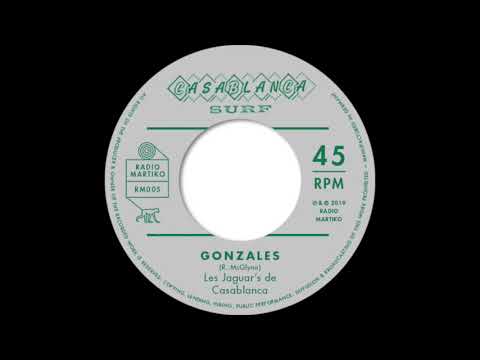Surfing on the shores of Java and Casablanca! 2 unexpected tales from the Beat generation.
A) De Evergreens - Es Lilin 03:07
B) Les Jaguar's de Casablanca - Gonzales 02:35
Tony Turpijn and his Evergreens fulfill the dream of every pantropical music lover with a silky instrumental rhythm ’n blues take on the Sundanese love song “Es Lilin” (Ice Lolly). Link Wray meets Mulatu Astatke meets Oslan Husein in Rotterdam, 1965.
Obscure formation Les Jaguar’s de Casablanca beat the Shadows …
Read More
Surfing on the shores of Java and Casablanca! 2 unexpected tales from the Beat generation.
A) De Evergreens - Es Lilin 03:07
B) Les Jaguar's de Casablanca - Gonzales 02:35
Tony Turpijn and his Evergreens fulfill the dream of every pantropical music lover with a silky instrumental rhythm ’n blues take on the Sundanese love song “Es Lilin” (Ice Lolly). Link Wray meets Mulatu Astatke meets Oslan Husein in Rotterdam, 1965.
Obscure formation Les Jaguar’s de Casablanca beat the Shadows with a boss version of the surf classic “Gonzales”. The band consists of a French/Spanish guitar section and a Moroccan rhythm section, featuring the eccentric drummer/percussionist Jauk Armal, the “Okay Temiz from Casablanca”. “Gonzales” is originally recorded in 1962 and released by “La Voix Du Maghreb” in Morocco on an ultra collectible EP, which is now impossible to find.
A little word by the reissuer (Fred Kramer, Radio Martiko):
The discovery of the dreamy “Es Lilin” by the Dutch-Indo ballroom band “The Evergreens” was one of the highlights of 2018 for Radio Martiko. A friend and accomplished sound digger Milan Hulsing from Delft in the Netherlands offered me a copy of the original 45 as a swap for another collectible record. When blasting it through my speakers, the laid back guitar riffs sent me over the moon and the idea of reissuing the tune came up naturally. The very same day I started to track down some band members which were credited on the backside of the cover. On the net I found a trace, which led to the lead guitar player Tony Turpijn, and soon I got in touch with him through his granddaughter. The man was excited by my proposal and gave me his blessing.
The Evergreens - mistakenly credited as “De Evergreens” on the original issue - were formed in 1965 and led by drummer/vocalist Ruud Reindorp, a man who was a prominent figure in the Dutch Indo Rock scene. Other members of the band were John Wessel on bass, Nos Lapré on vocals, Tony Turpijn on lead guitar and Ruud Wunderlich on rhythm guitar. The Evergreens were among the last batch of many Indo rock ’n roll formations that boomed since 1958 in Den Haag, Rotterdam and all over the Netherlands. Other important bands from that school were the famous Tielman Brothers and the Skyrockets.
In the late fifties, American rock n’ roll and other western dance music blew over Indonesia due to American (AFN) radiostations in the region. Right around that time the first Dutch-Indonesian musicians were repatriated to the Netherlands in the aftermath of their homelands independence, bringing their tropical culture and a passionate love for guitars and rock’n roll.
The Evergreens mainly played music at Dutch-Indo dance parties and gatherings and got attention through their regular performances for Radio Sinar Sang Surya at the then trendy Radio Veronica. Besides playing uncut western rock ’n roll, they characterised the subculture by re-arranging Indonesian popular songs and Kroncong (romantic Indonesian music) into latin, r&b and rock flavoured versions. Since 1968, the band’s line-up changed several times. Nowadays, with Tony Turpijn, being the only original member, the Evergreens like to play a versatile repertoire. Despite the long existence of the band, they only recorded one single and one full LP.
The song “Es Lilin” is a Sundanese (West Java) folksong (daerah) in the melancholic pélog scale. The melody line feels very old and is composed on an ancient Gamelan scale from Java. The lyrics are a love poem referring to a kind of ice cream from Bandung. The song belongs to the classic repertoire of Indonesian folk and reflects the age-old cultural crossovers in the archipel.
The Evergreen’s sloppy instrumental version of “Es Lilin” lets the intoxicating melody bounce on a monster r&b groove and reminds us of Ethio Jazz. The old Gamelan scale is modified here from 7 to 5 notes, which is similar to the Ethiopian “Tizita” scale.
For the flip side of this 45 we’re taking an unforeseen turn by selecting a Shadows cover.
I had never expected to pick a track by the British Kings of Pop to add up to our discography. I don’t remember hearing at some point a truly interesting Shadows cover, apart from some mediocre variants from the former Eastern Bloc, until a DJ friend from Montréal Philippe Noel faced me with the striking surf instro “Gonzales”, played by a band called “Les Jaguar’s de Casablanca”.
I got very much intrigued by the tune, because I noticed that it was released by “La Voix Du Maghreb”, one of the first record labels established in Casablanca. The label started releasing Shellac records that were pressed in France. At the dawn of the sixties they founded an independent record pressing company “Disco Maghreb” in strong competition with Boussiphone’s “Africson” factory and started pressing vinyl records for all of Morocco. There are not so many 45’s to discover on “La Voix du Maghreb”, because soon after setting up the vinyl production the enterprise changed their name to Koutoubiaphone. The label is long-defunct but their vintage-looking distribution center in downtown Casablanca is still open and has now become a real attraction for vinyl tourism. The Jaguars’ first EP on “Voix du Maghreb is a real rarity. I have travelled regularly to Morocco in the past and I never got my hands on a copy. Further I couldn’t recall any other digger showing off with it.
The Jaguars’ “Gonzales” appeared to me as a standard surf instrumental, but I couldn’t identify it at first. I liked the raw garage sound and the fact that it was recorded in Morocco. When I looked closer at the picture sleeve of the 45, I saw that two of the band members didn’t exactly look like Moroccans, especially the tall blond guy with glasses who seemed to be the exact double of Shadows icon Hank Marvin. Still, only later I found out that “Gonzales” was actually a Shadows evergreen.
My first call with Jauk Armal aka “Le Gnaoui Blanc” was only a few months ago. The 74-year old eccentric drummer/percussionist from Casablanca, who’s still active with his band “Jauk Dakka”, calls himself the father of “World Music”. He was one of the pioneers to fuse Moroccan trance music like Ahwach and Gnawa with jazz, rock and electro. In the late 80’s Jauk released 3 albums on different experimental and world music labels in France and Germany. I got in touch with him through young artists from Casablanca’s music scene where Jauk is still seen as a great mentor and percussion teacher. I was excited to find out that Jauk played the drum parts on that fantastic obscure Jaguars 45 and I quickly understood that this recording was the start of this musician’s passionate course of life.
Jauk Armand Lemal was born in 1944 as the child of an Andalusian mother and a Judeo-Berber father. He grew up in the popular neighbourhoods of French Casablanca with his mother and adoptive father. At a very young age, Jauk was devoted to the drum sticks, harmonica playing and dancing. He was sent to Music Academy but soon left to learn to play jazz drums on his own. Around 1958 he meets a Spanish college kid called Arthur Martinez, who plays guitar and introduces him to Francis Lortet (Titi), a flamboyant French rock ’n roll cat and superb lead guitarist. Together with Jewish and Jewish-Moroccan friends Saul Amar (Dany Océan), Samy Saoudy (Saga) and Léon Cohen, they formed “Les Anges Bleus”, “Les Albinos” and finally “Les Jaguars de Casablanca” in 1959 under supervision of Flore Artheney, a veterinarian and Maecenas who opened an atelier for young musicians at his office close to the abattoirs in Casablanca. Artheney got the funny nickname “Le Sacha Distel Marocain”. Nowadays “The Abattoirs of Casablanca” are not coincidentally a centre of arts.
The Jaguars gained their succes between 1959 and 1965. By 1967, when life conditions for Jewish and Christians in Morocco had become difficult, all the band members, except Jauk Armal, finally had to leave the country.
Due to the mainly French-speaking audience, the band had a predilection for French rock ’n roll songs and instrumentals from artists like Johnny Halliday, Jacques Dutronc, Françoise Hardy, Nino Ferrer, Eddie Mitchell, Les Chats Sauvages, Les Fantômes, etc. Being a devastating hitmachine, they also played the repertory of The Beatles, Rolling Stones, The Shadows, Fats Domino, Django Reinhard, Dave Brubeck and others. The Jaguars were the stars of the famous music hall “Le Village” in Casablanca. They played at the big Arena alongside Richard Anthony and had a 8-year contract at a jet-set club in Marbella. Regular appearances on TV-shows and gigs at theatres, clubs and casinos made this band an established name all over Morocco. Unfortunately, just like the Evergreens from Holland, they have always operated in nightlife entertainment and never recorded too much of their music. The discography of the Casablanca rockers covers two EP’s, recorded in 1962 for “La voix Du Maghreb”. Radio Martiko is happy to share “Gonzales” on a strong sounding repress, which is well deserved!
Read Less



